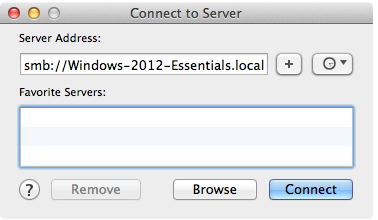 Apple has a long history with computer networking, from AppleTalk to today’s Internet connected world. However, it is Windows networking that still causes all kinds of headaches for Mac OS X users. It seems that with every release of Mac OS X, Apple seems to have recurring issues with Windows shares. Some of Apple’s defenders will state that Apple adopts industry standards as is, and it is Microsoft and others who publish specs, but don’t actually follow them, so when Apple does follow the specs, it seems to just end up breaking things. SMB is the networking protocol that Microsoft uses for Windows networking. It is what allows Windows network file shares to work across the network. With the latest versions of Mac OS X, Apple abandoned the open source SAMBA package that most Linux distros use to connect to Windows, and wrote their own SMB2 software. This makes Mac OS X 10.9 Mavericks connect faster and better to Windows servers. Well that is when it works!
Apple has a long history with computer networking, from AppleTalk to today’s Internet connected world. However, it is Windows networking that still causes all kinds of headaches for Mac OS X users. It seems that with every release of Mac OS X, Apple seems to have recurring issues with Windows shares. Some of Apple’s defenders will state that Apple adopts industry standards as is, and it is Microsoft and others who publish specs, but don’t actually follow them, so when Apple does follow the specs, it seems to just end up breaking things. SMB is the networking protocol that Microsoft uses for Windows networking. It is what allows Windows network file shares to work across the network. With the latest versions of Mac OS X, Apple abandoned the open source SAMBA package that most Linux distros use to connect to Windows, and wrote their own SMB2 software. This makes Mac OS X 10.9 Mavericks connect faster and better to Windows servers. Well that is when it works!
SMB Connections Fail
There is one Windows 2012 Essentials server with multiple shares. There are two Macs on the local network. One iMac is connected over Wireless N and one MacBook Pro is using a wired ethernet 1Gb connection. When using the Connect to Server… option the iMac connects fine and has no issues. The MacBook Pro opens the share and then never displays any files, it just spins in the lower left hand corner of the window that opens. Both computers are running Mac OS X 10.9.3 Mavericks.

Connecting via CIFS instead of SMB seems to work for the MacBook, but it is slower.
The Solution
The solution ended up modifying the Windows 2012 Essentials server. There are two registry keys that need to be added in order to fix the problem for the MacBook.
Under this Registry Key:
- HKEY_LOCAL_MACHINE\SYSTEM\CurrentControlSet\Services\LanmanServer\Parameters
Add these DWORD values:
- Smb2CreditsMin – make this 768
- Smb2CreditsMax – make this 16384
Once you made the changes restart the Windows Server and then the Macintosh clients. It should now fix the problem.
Microsoft provides the following information on these registry keys:
The defaults are 512 and 8192, respectively. These parameters allow the server to throttle client operation concurrency dynamically within the specified boundaries. Some clients might achieve increased throughput with higher concurrency limits, for example, copying files over high-bandwidth, high-latency links.
